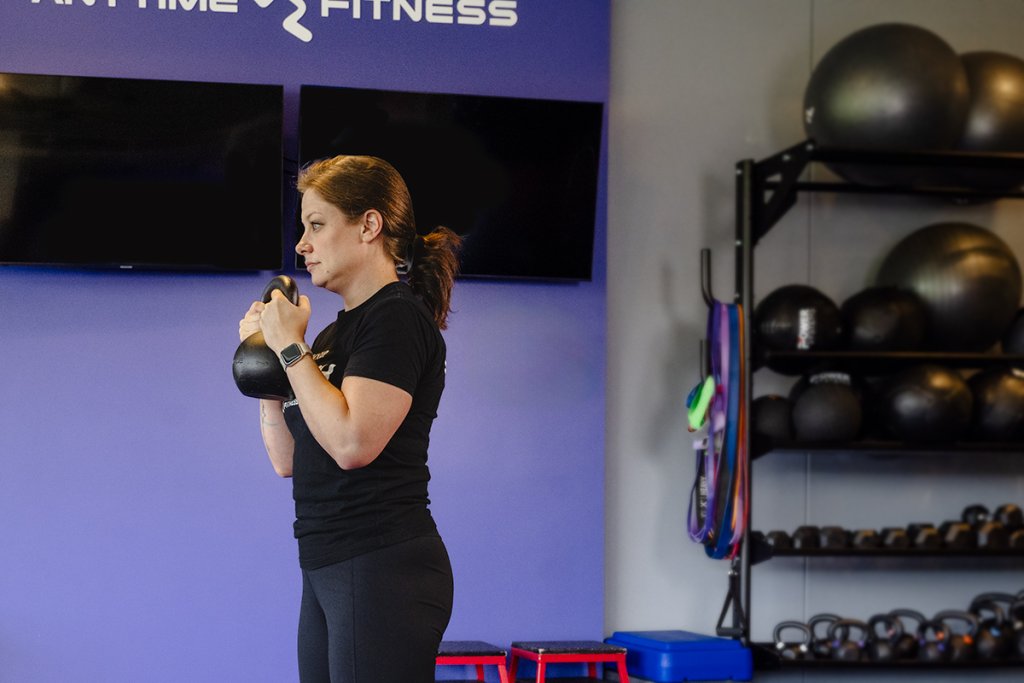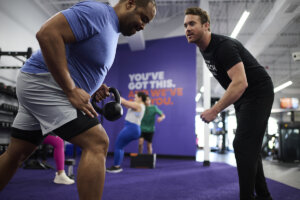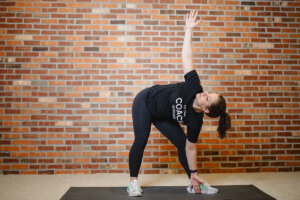If you’re a gym beginner — or haven’t had a membership for a while — it can be a bit intimidating at first. But the hardest part of any fitness journey is making the decision to make healthy happen, and you’ve already done that. To help make the next leg of your journey easier, here are some tips for achieving your wellness goals and making the most of your beginner gym workouts, plus a beginner strength training routine.
3 reasons to prioritize strength training
When most people start going to the gym, they’ll resort to what they’re comfortable with. Oftentimes, that’s a cardio machine. And while we’re not here to say that cardio isn’t a key component of your workout program — it is! — we’re here to say that a balanced routine that incorporates strength training and cardio workouts is the way to go.
Here’s why you should incorporate weight training into your workout routine — even at the beginner level:
- You’ll burn a surprising number of calories: Lifting weights boost metabolism, meaning your body burns more calories throughout the day, promoting higher fat burn. But that’s not even the best part. Once your workout is over, your body will continue to burn calories thanks to something called “excess post-exercise oxygen consumption.” And the more intense your workout, the longer it takes your body to return to its normal state. Which means more weight loss and calories burned, baby.
- Strength training protects bone health and muscle mass: As we age, we lose muscle mass and bone density, so strength training can help you combat the effects of aging to make your bones, joints, and muscles healthier and stronger.
- It helps improve mobility, longevity, and daily activities: Not only does strength training make you stronger, it also can help improve your balance, coordination, posture, and flexibility, making daily activities easier and enhancing your quality of life.
Strength training for beginners: How to get started
If you’re new to strength training, you may have searched for “strength training for beginners” — but let’s take a moment to think about your reason for wanting to focus on your health and fitness. This is your “why.” Write it down and use it to motivate you and drive you each day. And when you have a day of doubt and wonder whether all of the time and energy you put into your workouts are worth it, come back to your “why” and use it as your guiding principle. It’ll help put things into perspective.
Strength training is a powerful tool for improving your health and fitness. By understanding the basics and incorporating different types of strength training, you can create a balanced and effective beginner weight lifting routine.
Lifting weights vs. cardio
Both lifting weight and doing cardio have their own benefits, and the right balance depends on your individual fitness goals.
- Cardio is excellent for improving cardiovascular health, burning calories, and enhancing endurance. It’s particularly effective for weight loss.
- Strength training, on the other hand, focuses on building muscle, increasing strength, and boosting your metabolism. It also helps improve bone density and overall body composition.
For beginners, incorporating both cardio and strength training into your workout routine can provide a well-rounded approach to fitness.
Choose a fitness or training goal
What would you like to accomplish? Are you hoping to lose weight? Maybe you want a workout routine that will build muscle. Or it could be that you’re simply aiming to get to the gym two or three times a week.
When determining your workout goal, it helps to think SMART: Specific, Measurable, Achievable, Realistic, and Timely. Let’s break it down:
- Specific: You might say, “I want to work out more.” That’s fantastic! But a little vague. Try to get a tad more specific, like: “I want to feel stronger and have more energy.” Or, you could get even more granular and say, “I want to get stronger and be able to do 20 push-ups within six weeks.”
- Measurable: Rather than saying, “I want to work out more,” make sure your goal is measurable. For example, “I want to go to the gym three days every week and work out for 45 minutes each time.”
- Achievable: “I want to work out for two hours every day” is unrealistic (not to mention, hard on your body). If we consistently fail to meet our goals, it’s human nature to become disheartened and lose motivation. It also becomes easier to make excuses for ourselves. We suggest starting with a challenging but achievable goal that may not always be easy, but is within reach.
- Relevant: It’s important to consider the big picture when setting a health goal, such as your current fitness level, your lifestyle, and time commitments you have. If you’re a beginner to working out, find gym workouts that are aimed at beginners (like the one below!). If you know you can get to the gym during the weekdays, but weekends are always packed, make sure to keep that in mind during the planning phase.
- Timely: Setting a (realistic) timeframe for meeting your goals is a huge motivator. If your goal is to get to the gym three days a week indefinitely, it’ll feel huge. Instead, set the goal for the next four months, and see how you feel at that time.
Once you’ve decided on your fitness goal, write it down. Tell your best friend or gym buddy. By vocalizing your gym goal, you’re more likely to hold yourself accountable and find success.
Learn how to make the most of your time at the gym
Now that your goal is set and your mind is right, lace up those tennis shoes and grab your water bottle. It’s gym time. Here are a few tips for that first day.
- Try group training: Gym workouts and group training sessions are both great ways to challenge yourself, improve your performance, learn something new, and meet like-minded people.
- Get a personalized beginner weight lifting routine: Investing in a personal coach or trainer can save you so much time. They can help create or refine your workout routine, suggest adjustments, and provide support and expertise right when you need it most. Not to mention, you’ll have a gym buddy that can ensure accountability and boost motivation on days when you might need it.
- Be patient: It is all about progress. Each milestone, big or small, is a step toward your goal. And if a day didn’t go as planned, don’t be hard on yourself. It happens to all of us, and it’s more important to refocus your thoughts on getting back on track for the next workout.
Strength training for beginners: Types of strength training
Strength training isn’t one-size-fits-all. There are various types of strength training, each with its own focus and benefits.
1. Agility
Agile strength is about moving quickly and efficiently through different movements. This type of training improves coordination and balance and is great for playing sports that require quick changes in direction, like basketball, pickleball, or soccer.
2. Endurance
Endurance strength focuses on the ability to sustain prolonged physical activities. It’s crucial for sports and activities that require long periods of exertion. This type of strength training is great for improved cardiovascular health and, of course, enhanced muscular endurance and stamina.
3. Explosive strength
Explosive strength is all about using a maximum amount of force in a short period. Think of activities that require sudden bursts of energy, such as sprinting or jumping.
4. Maximum strength
The goal of maximum strength training is to lift the heaviest weight possible for one or very few repetitions. This type of training is common in powerlifting.
5. Speed strength
Speed strength combines strength and speed to produce powerful movements quickly. It helps increase agility, quickness, and overall athletic performance.
6. Starting strength
Starting strength focuses on the initial phase of a movement and the ability to generate force from a standstill — think lifting a heavy object off the ground.
7. Relative strength
Relative strength refers to the strength you have in relation to your body weight. It’s particularly good for activities where moving your body efficiently is key, such as gymnastics or rock climbing.
Strength training for beginners: The basics of sets, reps, and rest
Understanding the basics of sets, reps, weights, and rest is crucial for a successful beginner strength training routine.
Sets, reps, and rest
Reps (repetitions) refer to the number of times you perform a specific exercise. For example, lifting a dumbbell 10 times is 10 reps.
Sets are a group of consecutive repetitions. For instance, doing 10 reps of a dumbbell lift, resting, and then doing another 10 reps is two sets.
Beginner weight lifting routines could generally include 2–3 sets of 12–15 reps per exercise, using light weights. This helps build muscular endurance and joint stability, and allows you to master the movements with proper form before moving into the strength-building phase.
After about four weeks of muscular endurance training, increase the weights you’re lifting to moderately heavy weights, and increase your volume to 3-4 sets of 8-12 reps. This will promote the growth of muscle tissue. And don’t worry about how much time you’re taking. For now, you’ll want to concentrate on proper form and technique, rather than weight and reps.
- How to Do a Lat Pulldown With Perfect Form for Max Gains
- How To Improve Your Squat Form in 10 Steps
- Mastering Bench Press Form: 6 Tips to Blast Fat and Build Muscle
Depending on the type of workout you do, resting between sets can be beneficial. To improve muscular endurance, for example, you’ll generally keep rest periods between 20 and 60 seconds. As you get stronger and lift more, the rest periods will be longer to help fuel muscle growth — between 30 seconds and 2 minutes.
How long should I work out for?
The ideal workout time depends on your goals and your schedule, but a good place to start might be 30–60 minutes per session, including warm-up and cooldown periods. This duration is sufficient to work all major muscle groups without causing excessive fatigue. When you’re doing a gym workout plan for beginners, it’s the quality of your movement that matters more than the quantity, so try not to get hung up on how long your workout lasts.
How much weight should I lift?
When you first do a workout for strength training, you can use a light to moderate weights. Some movements can even be done with your bodyweight alone. Gradually increase the weight as you become more comfortable and get stronger. A good rule of thumb is to choose a weight that allows you to complete the desired number of reps while still challenging you by the last few reps.
Beginner Gym Workout for Strength Training
1. Treadmill Incline Walk Warm-Up
Every great workout routine starts with a warm-up. Pick a pace and set an incline on the treadmill that will get the blood flowing and your heart rate elevated. Walking on a treadmill at an incline is an effective warm-up that gets the blood flowing and primes your body for your workout. Start with a 5- to 10-minute warm-up.

2. Bird Dog
This exercise targets five major muscle groups and helps build core strength and stability.
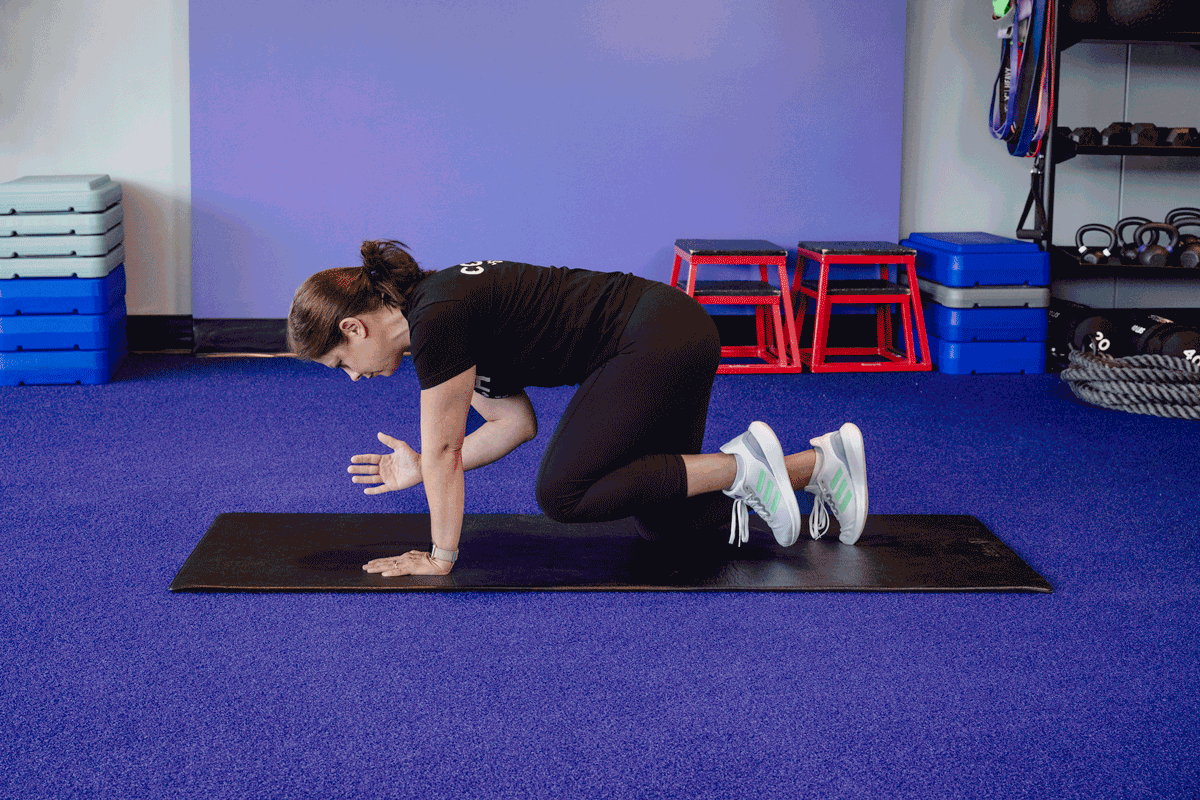
How to:
- Begin on all fours with only both knees and hands on the floor.
- Raise one arm and the opposite leg straight up to shoulder height, balancing on one hand and the opposite knee.
- Slowly lower your arm and leg and repeat with the other arm and leg.
- Perform 3 sets of 10 reps.
3. Goblet Squat
The goblet squat builds core and leg strength, all while helping you develop proper form by keeping your chest up as you hold the weight in the goblet position.
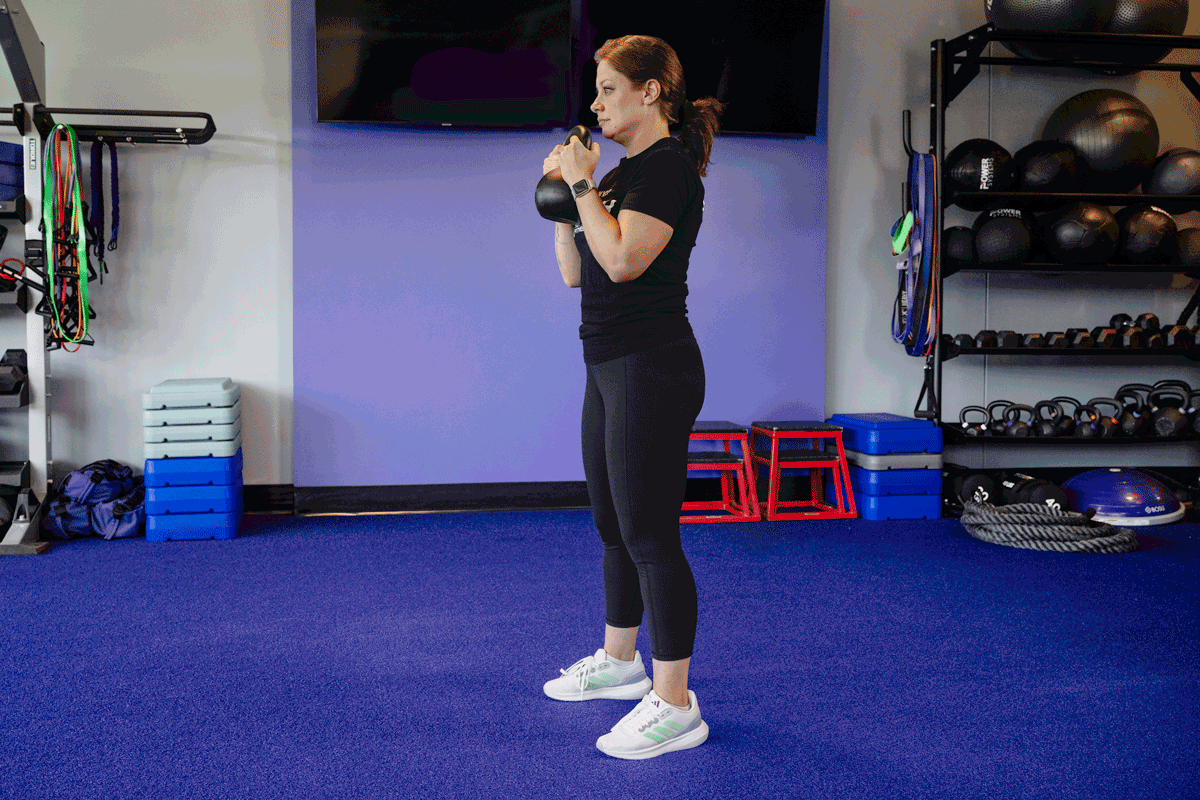
How to:
- Stand upright holding one dumbbell (weight of your choice) in both hands at chest height. Keep your feet flat, shoulder-width apart.
- Lower your body toward the floor, sending your hips back and down and bending your knees.
- Push through your heels to return to the start position, keeping your back flat and head up throughout the movement.
- Perform 3 sets of 10 reps.
4. Alternating Floor Press
Pressing in an alternating pattern helps build coordination as well as shoulder strength and stability.
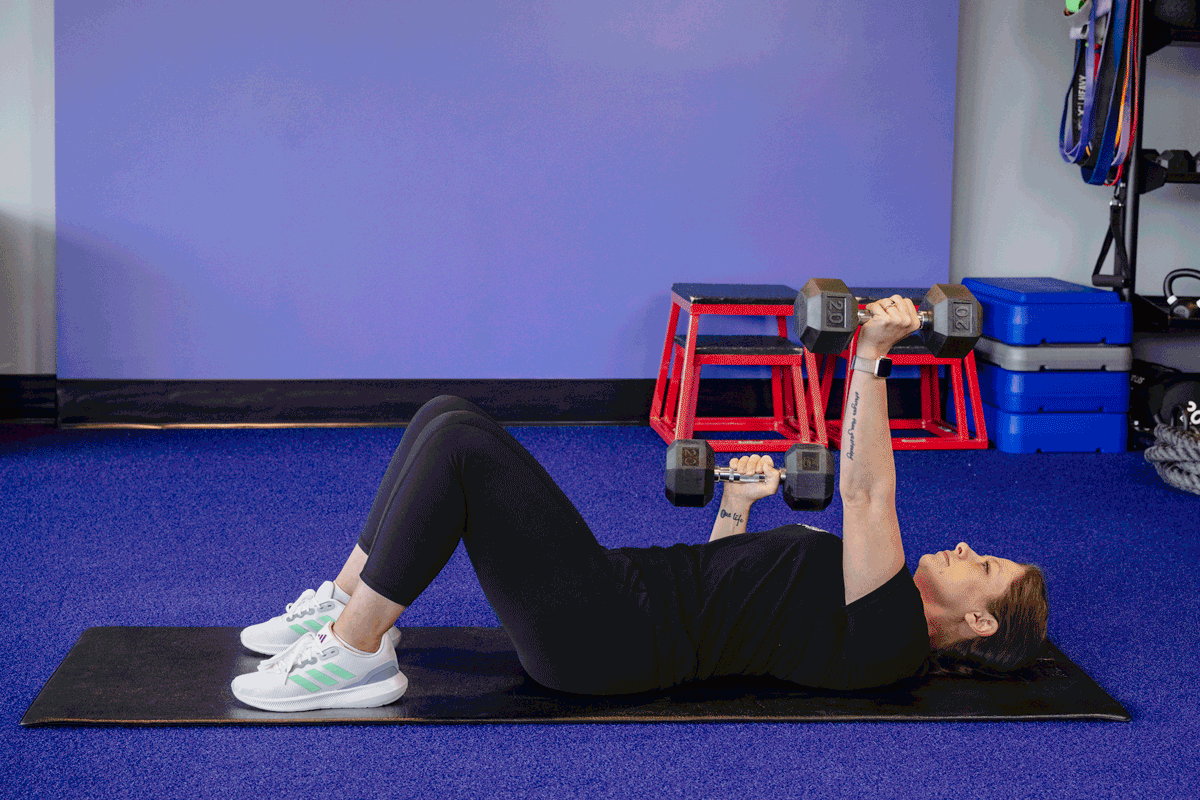
How to:
- Lie on the floor. Hold two dumbbells (weight of your choice) at shoulder level with your elbows bent and your palms facing in.
- Press the dumbbell straight up over your chest with your right arm, keeping your palms facing in.
- Lower the dumbbell back to shoulder level.
- Repeat with your left arm.
- Perform 3 sets of 10 reps for each arm.
5. Dead Bug
The dead bug is a classic exercise to improve your core strength as well as your coordination.
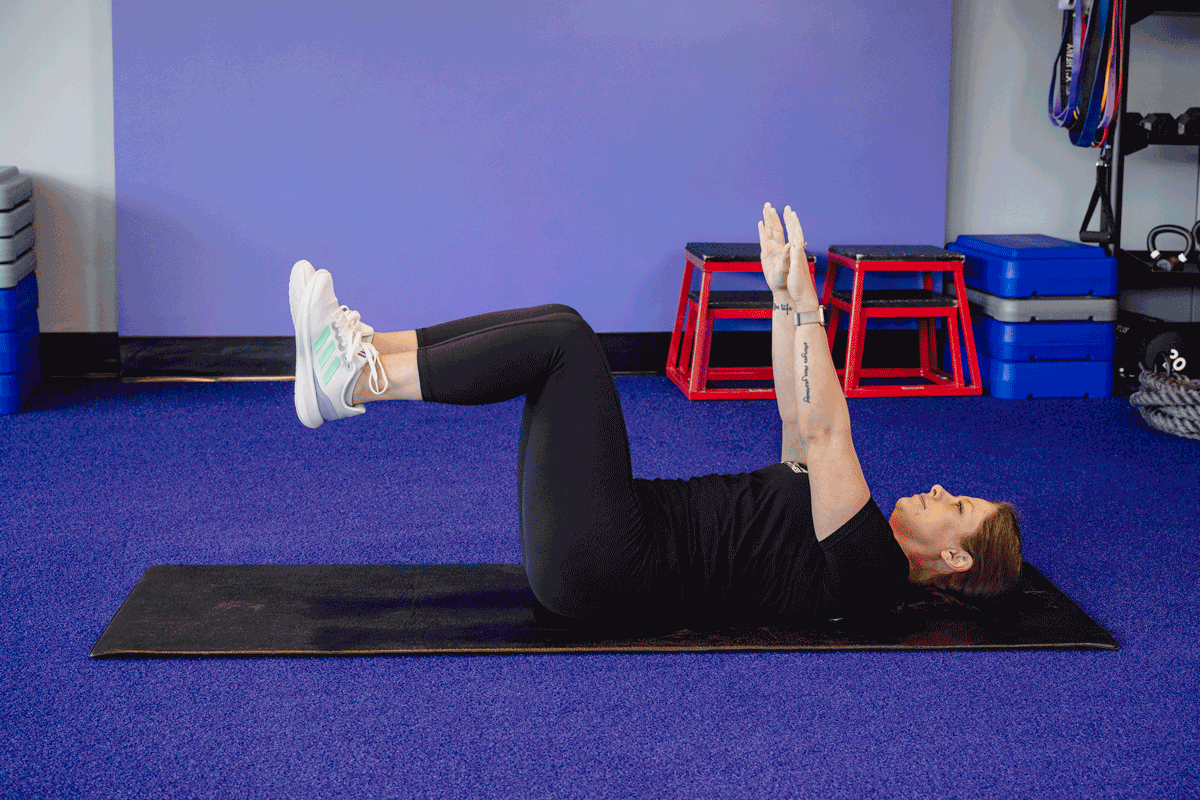
How to:
- Lie on your back with your knees bent and feet raised. Your arms will be straight up over your chest.
- Lower one leg and the opposite arm straight down toward the floor, keeping the other leg and arm steady.
- Raise the leg and arm back to the upright position and repeat with the opposite leg and arm. Alternate sides with each rep.
- Perform 3 sets of 10 reps.
6. Forward Lunge
Lunging is a knee-dominant movement that helps build joint strength, stability, and mobility.
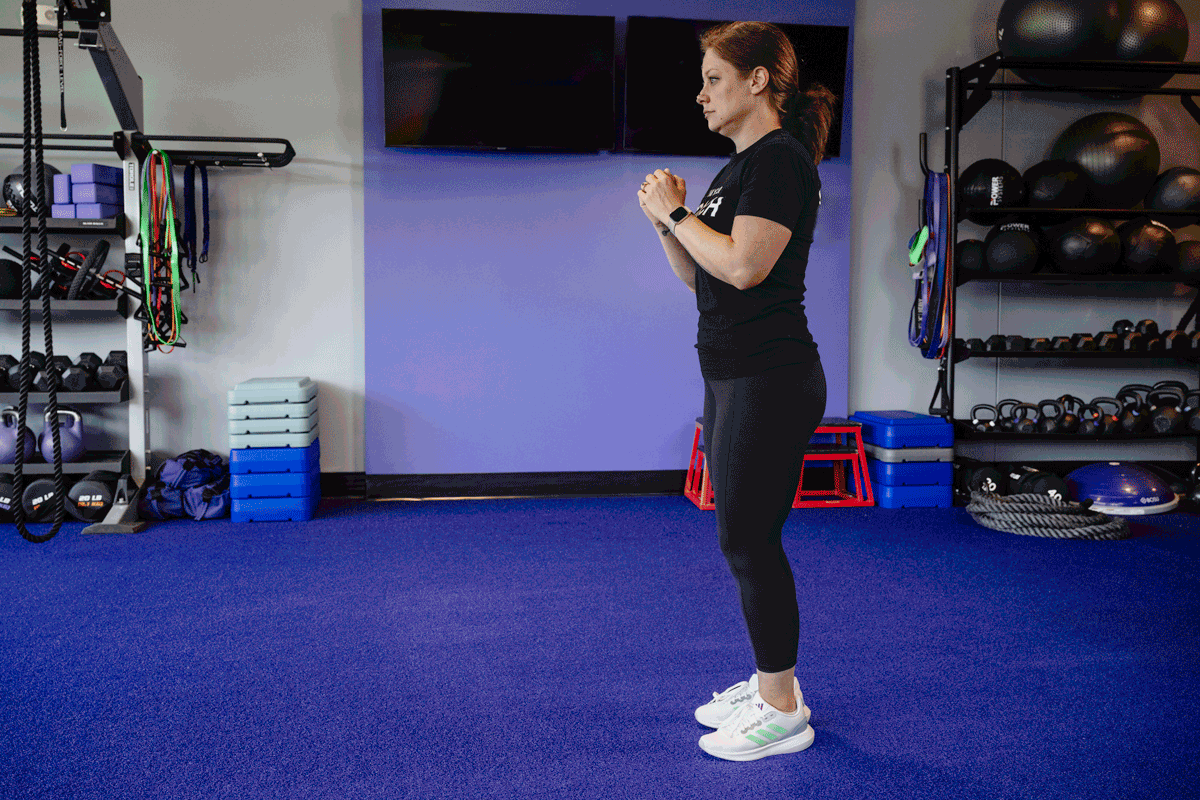
How to:
- Start standing up straight.
- Step forward with your right leg as you lower your left knee toward the ground.
- Drive through your heel as you step back into your starting position.
- Repeat with the other leg.
- Perform 3 sets of 10 reps.
7. Bench-Supported Bent Over Row
The single-sided bent over row targets the back and core while helping to address muscle imbalances.
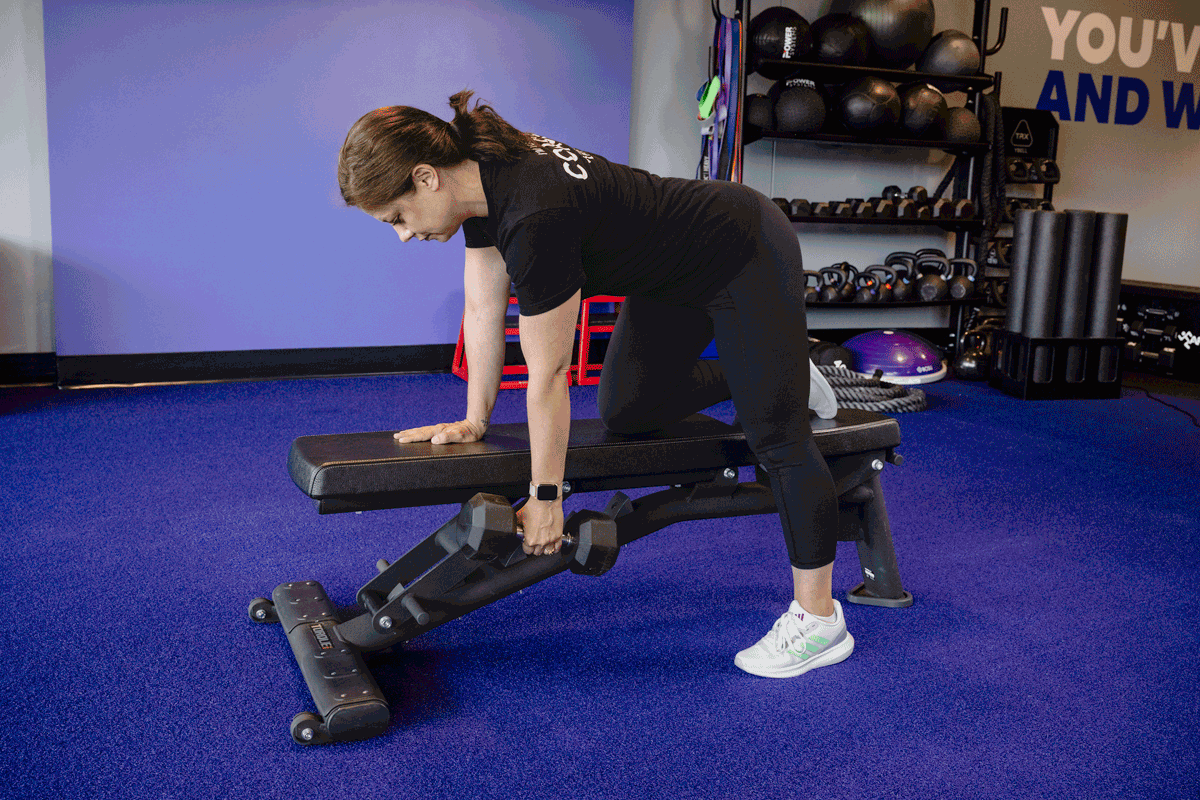
How to:
- Holding a dumbbell (weight of your choice) in one hand with your arm straight, place the opposite knee and hand on a bench. Keep your back flat.
- Lift the dumbbell up to the side of your chest, bending at your elbow.
- Lower the dumbbell back to a straight arm position, keeping your back flat throughout.
- Perform 3 sets of 10 reps per side. Complete all reps on one side before switching to the other side.
You did it! If that workout was challenging, that means you did it right. Practice, focus, and consistency are crucial, so don’t give up. Part of any great workout is finding what works for you.
More gym workout plans for beginners
If you liked this workout for strength training, check out our another beginner gym workouts that can build muscle, burn fat, and improve your overall wellness:
Just getting started? Whether your goal is to boost your power, muscle mass, and overall physical longevity, having a Coach that can create a personalized workout plan that suits YOU is a game-changer. Find the Anytime Fitness location nearest you for a FREE fitness consultation to get started on the right foot.
